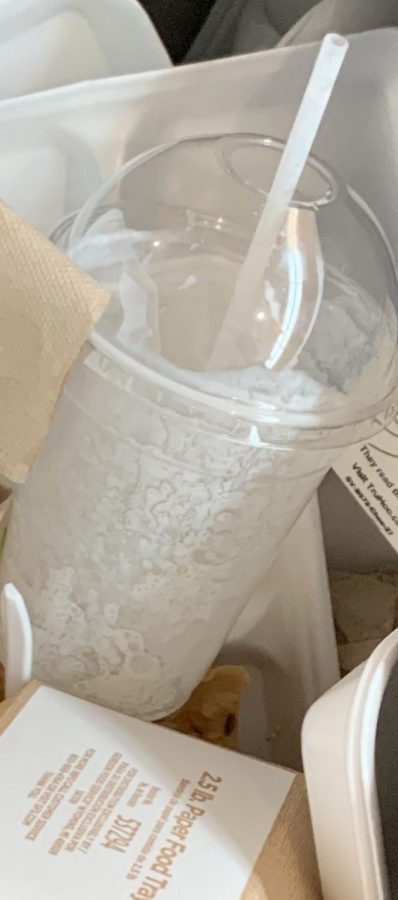Recycling: You’ve Been Lied To
Recyclable plastic is rarely properly recycled and ends up being incinerated.
October 8, 2021
Plastic is the plague of the 21st century.
Over 6.3 million tons of plastic waste are generated every year. If this trend continues, by the year 2050, there will be more pounds of plastic in the oceans than fish. While some plastic is recyclable, only 9% of that waste is recycled, 12% of plastic waste is incinerated, and 79% accumulates in landfills. Plastics take up to 1,000 years to disintegrate and often infiltrate local ecosystems where they endanger animals.
While plastics can have devastating effects on the well-being of animals, humans are also vulnerable to the toxicity of plastics. Nearly all humans have trace amounts of chemicals from plastics in their tissue and blood. Although it is not a major concern in low concentrations, in high concentrations, chemical toxicity can cause hormone disruption and adverse reproductive outcomes.
Plastics don’t just negatively affect humans and ecosystems; plastics are a climate issue. From cradle to grave, plastics emit greenhouse gases. The foundation of plastics are fossil fuels, which, when burned, release millions of tons of carbon dioxide into the atmosphere.
Whether it be animal endangerment, human health, or a climate issue, plastic pollution is dangerous and must be significantly reduced.
So the solution is recycling, right?
As early as elementary school, American schools indoctrinate children into a belief of recycling. We have fond memories of Earth Day activities where we learned to properly recycle.
In computer class, we played games like “Michael, Michael, Go Recycle!” wherein a kid named Michael stops evil children from littering by throwing their recycling and trash into the proper bins. Lesson upon lesson taught that the solution to the planet’s pollution problem was to look at the products we consume, check the label, and throw it into a green or blue bin.
Students aren’t alone in hearing this messaging. Billboards on the side of highways speak to drivers from the perspective of a plastic water bottle, begging, “I want to be a bench. Recycle me.”
Others present ideas of what their recycling could turn into, like a picture of a half-water jug turning into a winter coat that says, “Now you know what your empty beverage containers can become.”
These games, signs, and marketing campaigns all reinforce the same idea: the solution to pollution, specifically plastic pollution, is recycling.
That is false.
According to Erin McCormack at The Guardian, “Experts estimate that 20% to 70% of plastic entering recycling facilities around the globe is discarded because it is unusable.”
The history of plastic recycling is complex. Many people conjecture that plastic recycling was intended to curb the negative effects of plastic overall, but plastic companies originally introduced it as a way to increase profits.
In the 1980s, the societal perception of plastics was negative. Plastic companies were losing money and needed to improve public opinion. In order to fulfill their bottom line, plastic companies developed plastic recycling, a now hundred-billion dollar idea.
After a multi-million dollar advertising effort, sales improved significantly and the public approval rating increased. People truly believed that their plastic straw would one day become a chair. Instead, it became a death threat to marine life and it leached chemicals into our drinking water.
Plastic companies knew that recycling was never a viable option economically and environmentally. The amount of infrastructure needed to prevent plastic pollution was, and has always been, unrealistic and unattainable. However, the problem has worsened as of late.
The key to understanding the current problem with recycling plastics begins in China. For decades, China was the dumping ground for recyclables for the entire world. During the first half of 2017, China bought 60% of the recyclable plastics being exported from G7 countries.
This changed, however, when a movie called Plastic China went viral in the country. The documentary depicted a family of recycling workers, who spent their days salvaging useful plastics from a landfill of garbage, and also explained the immense pollution coming from the plastics which aren’t salvaged. In response, there was outrage from the Chinese people, demanding that they stop facilitating the recycling industry’s air pollution and abusive labor.
China banned the documentary from the country’s internet, but they still felt pressure to act. In 2018, they introduced their new “National Sword” recycling policy. National Sword prohibited dirty and useless waste from entering the country, and was incredibly effective. In just 1 year, China went from importing 1,200 tons of plastic waste to just 70.
After China stopped accepting all of this plastic, it had nowhere to go. Most of the plastic was diverted to Southeast Asian countries, like Malaysia, Vietnam, and Thailand. In Thailand specifically, the tons of new plastic imports created a shady recycling industry without enough environmental regulation. These new plants began implementing practices that are terrible for the environment, like removing the copper from electronic waste and incinerating the toxic remains, meaning that “recycled” materials were often causing more pollution than they would in a landfill.
A lack of public knowledge and infrastructure limits the effectiveness of recycling. While these may appear like solvable problems, the necessary infrastructure and public commitment to recycling is unfeasible. Thus, we must turn to other solutions.
Companies can have some of the greatest influence on the fight against plastic pollution. From packaging to product formulation, companies use plastic in almost every step of the process. By switching to more sustainable materials made of natural or recyclable alternatives, companies can provide more viable options for consumers and ultimately reduce their environmental footprint.
Some companies have already committed to reduce plastic waste. Revolution Bag, a company based in Little Rock, Arkansas, creates garbage bags by collecting agricultural film, which is then washed and recycled to produce PCRpro resin. This process is as cost effective and durable as single use plastics without hurting the environment.
While some companies are taking on the plastic problem willingly, their main goal is still to make profits.
Governments must hold companies accountable, especially on environmental protection standards. San Francisco, a trailblazer for zero-plastic waste, has implemented legislation that prevents retailers from using plastic bags in stores. This as well as other policies cut their plastic-bag pollution by 70%.
Policy change regarding plastic pollution can take years to implement, but individuals can make a positive impact every day.
The average person needs to focus on one thing: reducing their reliance on single-use plastics. Water bottles, plastic packaging, and other single-use plastics make up 40% of all plastics. Even if some of these products are marked as recyclable, they may not be, especially if they aren’t properly cleaned beforehand (a comprehensive guide to recycling and recyclable materials). If it’s too hard to determine whether something should be thrown away or recycled, it should probably be thrown out so it doesn’t contaminate other recyclables.
Being able to properly recycle these products is important, but decreasing one’s reliance on them is far more important. For example, bar shampoo is a great alternative to bottled shampoo. Often sold in paper packaging as opposed to a thick plastic shampoo bottle, bar shampoo has a much less detrimental impact on the environment. There are hundreds of plastic products like this that could be replaced. If consumers stop buying these products, companies will stop producing them, and they will no longer contribute to plastic pollution.
The green bin with the three arrows is a sign of hope to many. They hope that if enough people do their part, we’ll be able to curb the horrible excess of trash in our landfills and oceans. This hope is sadly misguided, because recycling alone will not solve our pollution problems. However, if that same hope and energy around recycling can be applied to lobbying local, state, and federal governments to take action against single-use plastics and to making the personal decision each day to limit one’s consumption of plastic products, real progress will be made.




